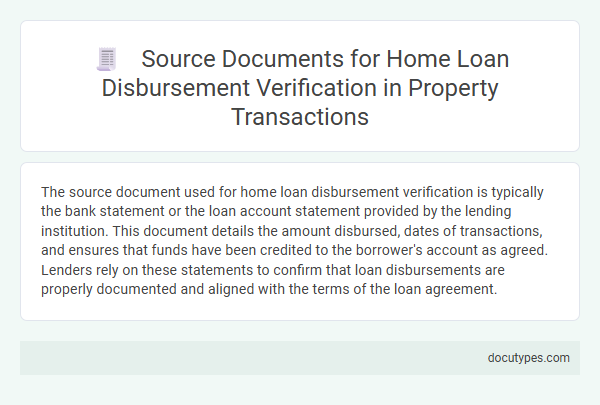The source document used for home loan disbursement verification is typically the bank statement or the loan account statement provided by the lending institution. This document details the amount disbursed, dates of transactions, and ensures that funds have been credited to the borrower's account as agreed. Lenders rely on these statements to confirm that loan disbursements are properly documented and aligned with the terms of the loan agreement.
Introduction to Source Documents in Home Loan Disbursement
What source document is used for home loan disbursement verification? Home loan disbursement verification requires specific source documents to ensure the legitimacy of the transaction. These documents help lenders confirm the proper use of loan funds and maintain transparency in the loan process.
Importance of Source Document Verification in Property Transactions
The primary source document used for home loan disbursement verification is the sanction letter issued by the lending institution, which details the loan amount and terms. Verification of this document ensures that loan funds are released according to agreed terms, preventing fraud and unauthorized transactions. Accurate source document verification is crucial in property transactions to maintain transparency, secure investments, and protect the interests of both lenders and borrowers.
Common Source Documents Required by Lenders
Common source documents used for home loan disbursement verification include the loan agreement, property sale deed, and bank statements confirming the transaction. Lenders also require the title deed and possession certificate to ensure the property ownership and handover. These documents help verify the proper utilization of loan funds and compliance with loan terms.
Sale Deed and Agreement to Sell
| Source Document | Purpose in Home Loan Disbursement Verification | Key Details |
|---|---|---|
| Sale Deed | Primary evidence to confirm ownership transfer before loan disbursement | Registered legal document proving ownership of property. Includes buyer and seller details, property description, sale consideration, and signatures. Essential for lenders to validate clear property title. |
| Agreement to Sell | Preliminary document used to demonstrate intent to transfer ownership | Contract outlining terms and conditions between buyer and seller before final sale deed registration. Highlights payment schedule, property details, and obligations of both parties. Helps lenders verify legitimate transaction progress. |
| Verification Process | Documentation review | Lenders examine Sale Deed and Agreement to Sell to confirm consistency and authenticity before releasing funds. |
| Legal verification | Legal teams or property experts validate documents for encumbrances, rightful ownership, and compliance with regulatory standards. | |
| Your home loan disbursement depends heavily on accurate verification of the Sale Deed and Agreement to Sell, ensuring the property transaction is legitimate and secure for financing. | ||
Title Deed and Encumbrance Certificate
Verification of home loan disbursement requires crucial source documents to ensure the property's legal status and ownership. Title Deed and Encumbrance Certificate stand as primary documents in this process.
- Title Deed - This document proves ownership of the property and is essential for confirming your legal rights before loan disbursement.
- Encumbrance Certificate - It certifies the property is free from any legal liabilities or financial encumbrances, ensuring a clear title.
- Verification Importance - These documents collectively help lenders verify the authenticity and safety of the property investment tied to your home loan.
Approved Building Plan and Occupancy Certificate
Home loan disbursement verification requires specific source documents to ensure proper fund release. The Approved Building Plan is crucial as it confirms that the construction meets legal and regulatory standards.
The Occupancy Certificate is another essential document that verifies the building is fit for habitation. Lenders rely on these documents to validate the property's compliance before approving loan disbursement.
Allotment Letter and Possession Letter
Verification of home loan disbursement requires specific source documents to ensure proper fund release. The allotment letter and possession letter play crucial roles in this verification process.
- Allotment Letter - This document confirms the property has been allocated to the buyer by the developer or builder.
- Possession Letter - This letter certifies that the buyer has received physical possession of the property.
- Loan Disbursement Verification - Both letters validate the stage of property acquisition, assisting banks in validating loan release.
Payment Receipts and Bank Statements
Payment receipts and bank statements serve as primary source documents for home loan disbursement verification. These documents confirm the transfer and receipt of loan amounts.
Payment receipts provide proof of payment made towards the property, detailing the amount and date of transaction. Bank statements reflect the inflow and outflow of funds, verifying the loan disbursement into the borrower's account. Together, these documents ensure transparency and accuracy in the home loan disbursement process.
Identity and Address Proof of Borrower
Source documents used for home loan disbursement verification primarily include identity and address proofs of the borrower. These documents verify the authenticity of the borrower's personal details and residential address.
Common identity proofs accepted are Aadhaar card, PAN card, or passport. Address proofs often include utility bills, rental agreements, or registered sale deeds to confirm the borrower's residence.
What Source Document Is Used for Home Loan Disbursement Verification? Infographic

